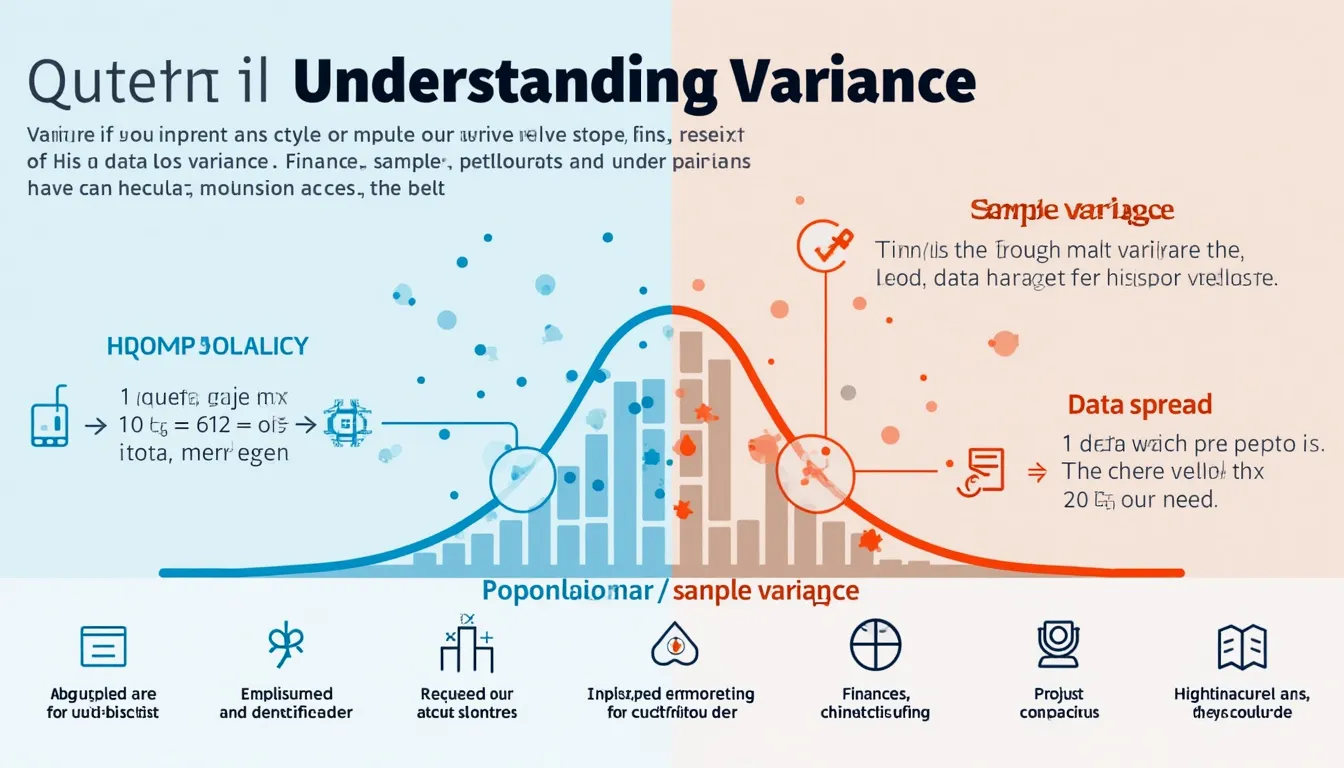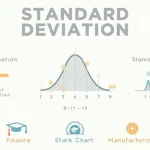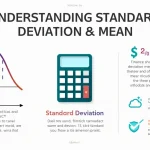Is this tool helpful?
How to Use the Variance Calculator Effectively
Step-by-Step Guide
Our Variance Calculator is designed to help you easily compute the variance and standard deviation of a dataset. Follow these simple steps to use the calculator effectively:
- Enter Your Data: In the “Enter Data Set” textarea, input your numbers. You can separate them using commas, spaces, or new lines. For example, you might enter: 2, 4, 4, 4, 5, 5, 7, 9
- Choose Variance Type: Select either “Population Variance” or “Sample Variance” from the dropdown menu. Choose “Population Variance” if your data represents the entire population, or “Sample Variance” if it’s a sample from a larger population.
- Optional Features:
- Check the “Show Calculation Steps” box if you want to see a detailed breakdown of the calculation process.
- Check the “Display Data Visualization” box to generate a bar chart representing your data distribution.
- Calculate: Click the “Calculate” button to process your data.
- Review Results: The calculator will display the mean, variance, and standard deviation of your dataset. If you selected the optional features, you’ll also see the calculation steps and/or data visualization.
Understanding Variance: Definition, Purpose, and Benefits
Variance is a fundamental concept in statistics that measures the spread or dispersion of a set of numbers from their average (mean) value. It provides crucial insights into data variability, helping researchers, analysts, and decision-makers understand the distribution and consistency of their data.
Definition of Variance
Mathematically, variance is defined as the average of the squared differences from the mean. There are two types of variance:
Population Variance (σ²)
$$ \sigma^2 = \frac{\sum_{i=1}^N (x_i – \mu)^2}{N} $$Sample Variance (s²)
$$ s^2 = \frac{\sum_{i=1}^n (x_i – \bar{x})^2}{n – 1} $$Where:
- xi represents each value in the dataset
- μ (population) or x̄ (sample) is the mean of the dataset
- N is the total number of values in the population
- n is the number of values in the sample
Purpose of Calculating Variance
The primary purposes of calculating variance include:
- Measuring Data Spread: Variance quantifies how far a set of numbers are spread out from their average value.
- Assessing Risk: In finance, variance is used to evaluate the volatility of investments.
- Quality Control: Manufacturing processes use variance to monitor product consistency.
- Research Analysis: Scientists use variance to analyze experimental results and assess the significance of their findings.
- Decision Making: Variance helps in making informed decisions by providing a measure of data reliability.
Benefits of Using a Variance Calculator
Our Variance Calculator offers several advantages:
- Time-Saving: Quickly compute variance without manual calculations.
- Accuracy: Eliminate human error in complex mathematical operations.
- Flexibility: Calculate both population and sample variance with ease.
- Educational Value: View step-by-step calculations to understand the process.
- Visual Representation: Generate data visualizations for better insights.
- Accessibility: Use on any device with an internet connection.
How the Variance Calculator Addresses User Needs
Our Variance Calculator is designed to solve specific problems and meet various user needs across different fields:
1. Statistical Analysis in Research
Researchers often need to analyze the variability in their data to draw meaningful conclusions. Our calculator simplifies this process by providing quick and accurate variance calculations, allowing researchers to focus on interpreting results rather than performing tedious calculations.
Example Calculation:
A biologist studying plant growth records the heights (in cm) of 10 plants: 15, 18, 22, 19, 20, 23, 17, 21, 20, 16
Using our calculator:
- Enter the data: 15, 18, 22, 19, 20, 23, 17, 21, 20, 16
- Select “Sample Variance” (assuming these are a sample from a larger population)
- Click “Calculate”
Results:
- Mean: 19.1 cm
- Sample Variance: 6.7667 cm²
- Standard Deviation: 2.6013 cm
This information helps the biologist understand the spread of plant heights in their sample, which is crucial for further statistical analyses and drawing conclusions about the overall plant population.
2. Financial Risk Assessment
In finance, variance is a key measure of investment risk. Our calculator enables financial analysts and investors to quickly assess the volatility of different investments or portfolios.
Example Calculation:
An investor wants to compare the risk of two stocks based on their monthly returns over the past year:
Stock A returns (%): 2.5, 1.8, -0.5, 3.2, 2.0, 1.5, -1.0, 2.8, 3.5, 1.2, 0.8, 2.2
Stock B returns (%): 5.0, -2.5, 4.2, -1.8, 3.5, -3.0, 6.2, -2.2, 4.8, -1.5, 5.5, -3.8
Using our calculator for Stock A:
- Enter the data: 2.5, 1.8, -0.5, 3.2, 2.0, 1.5, -1.0, 2.8, 3.5, 1.2, 0.8, 2.2
- Select “Population Variance” (as we have data for the entire year)
- Click “Calculate”
Results for Stock A:
- Mean: 1.6667%
- Population Variance: 1.8889%²
- Standard Deviation: 1.3745%
Repeating the process for Stock B yields:
- Mean: 1.2833%
- Population Variance: 13.7464%²
- Standard Deviation: 3.7076%
The investor can now see that while Stock B has a slightly lower average return, it has a much higher variance, indicating greater volatility and potentially higher risk.
3. Quality Control in Manufacturing
Manufacturing processes rely on consistent product dimensions. Our Variance Calculator helps quality control engineers quickly assess product variability.
Example Calculation:
A factory produces bolts with a target diameter of 10mm. The quality control team measures 15 bolts:
Bolt diameters (mm): 9.98, 10.02, 10.05, 9.99, 10.01, 10.03, 9.97, 10.00, 10.04, 9.96, 10.02, 10.01, 9.99, 10.03, 10.00
Using our calculator:
- Enter the data: 9.98, 10.02, 10.05, 9.99, 10.01, 10.03, 9.97, 10.00, 10.04, 9.96, 10.02, 10.01, 9.99, 10.03, 10.00
- Select “Sample Variance” (as these are a sample of all produced bolts)
- Click “Calculate”
Results:
- Mean: 10.0067 mm
- Sample Variance: 0.0007 mm²
- Standard Deviation: 0.0263 mm
This low variance indicates that the bolt diameters are consistently close to the target, suggesting good quality control in the manufacturing process.
Practical Applications of the Variance Calculator
Our Variance Calculator has a wide range of practical applications across various fields:
1. Education and Academic Research
- Student Performance Analysis: Educators can use the calculator to analyze the spread of test scores, helping identify whether teaching methods are consistently effective across all students.
- Research Data Analysis: Researchers in fields like psychology, sociology, or biology can quickly assess the variability in their experimental data.
2. Business and Economics
- Market Research: Analyze the variability in consumer preferences or spending habits.
- Sales Forecasting: Assess the reliability of sales predictions by calculating the variance in historical sales data.
- Inventory Management: Optimize stock levels by understanding the variability in demand for different products.
3. Finance and Investing
- Portfolio Management: Calculate the risk (variance) of different investment portfolios to make informed decisions.
- Options Pricing: Variance is a key component in options pricing models like Black-Scholes.
- Risk Assessment: Evaluate the volatility of different financial instruments or markets.
4. Science and Engineering
- Environmental Studies: Analyze the variability in pollution levels, temperature changes, or other environmental factors.
- Engineering Quality Control: Assess the consistency of manufactured parts or the reliability of engineering systems.
- Medical Research: Evaluate the variability in patient responses to treatments or drug efficacy across different groups.
5. Sports Analytics
- Player Performance Analysis: Assess the consistency of athletes’ performances across seasons or games.
- Team Strategy: Analyze the variability in team statistics to identify areas of inconsistency that need improvement.
Frequently Asked Questions (FAQ)
Q1: What’s the difference between population variance and sample variance?
A1: Population variance is used when you have data for an entire population, while sample variance is used when you have a subset of data from a larger population. The main difference is in the denominator of the formula: population variance divides by N (total population size), while sample variance divides by n-1 (sample size minus one) to provide an unbiased estimate of the population variance.
Q2: Why is the standard deviation also provided with the variance?
A2: Standard deviation is the square root of variance and is often preferred because it’s in the same units as the original data. This makes it easier to interpret and use in further statistical analyses.
Q3: Can I use this calculator for large datasets?
A3: Yes, our calculator is designed to handle large datasets efficiently. However, for extremely large datasets (thousands of data points), you might experience a slight delay in processing.
Q4: How does the data visualization feature work?
A4: When you check the “Display Data Visualization” box, the calculator generates a bar chart showing the frequency distribution of your data. This helps you visually understand the spread and central tendency of your dataset.
Q5: Can I use this calculator for data with decimal points?
A5: Absolutely! Our calculator can handle both whole numbers and decimal values. Simply input your data as you would normally, separating each value with a comma, space, or new line.
Q6: What if I have negative numbers in my dataset?
A6: The variance calculator can handle negative numbers without any issues. Variance measures the spread of data regardless of whether the values are positive or negative.
Q7: How accurate are the calculations?
A7: Our calculator uses precise mathematical formulas and is designed to provide highly accurate results. The calculations are performed to several decimal places to ensure precision.
Q8: Can I save or export my results?
A8: Currently, the calculator doesn’t have a built-in save or export function. However, you can easily copy the results displayed on the screen or take a screenshot for your records.
Q9: Is there a limit to how many numbers I can input?
A9: While there’s no strict limit, the calculator is optimized for datasets typically used in statistical analysis. For extremely large datasets (tens of thousands of points), you might want to consider using specialized statistical software.
Q10: How does this calculator handle outliers in the data?
A10: The variance calculator includes all data points in its calculations, including outliers. Variance is sensitive to outliers, which can significantly affect the result. If you suspect outliers in your data, it’s important to investigate them separately before deciding whether to include them in your variance calculation.
By addressing these common questions, we hope to provide a comprehensive understanding of our Variance Calculator and its capabilities. Whether you’re a student, researcher, financial analyst, or professional in any field dealing with data analysis, this tool is designed to simplify your statistical calculations and provide valuable insights into your data’s variability.
Important Disclaimer
The calculations, results, and content provided by our tools are not guaranteed to be accurate, complete, or reliable. Users are responsible for verifying and interpreting the results. Our content and tools may contain errors, biases, or inconsistencies. We reserve the right to save inputs and outputs from our tools for the purposes of error debugging, bias identification, and performance improvement. External companies providing AI models used in our tools may also save and process data in accordance with their own policies. By using our tools, you consent to this data collection and processing. We reserve the right to limit the usage of our tools based on current usability factors. By using our tools, you acknowledge that you have read, understood, and agreed to this disclaimer. You accept the inherent risks and limitations associated with the use of our tools and services.







